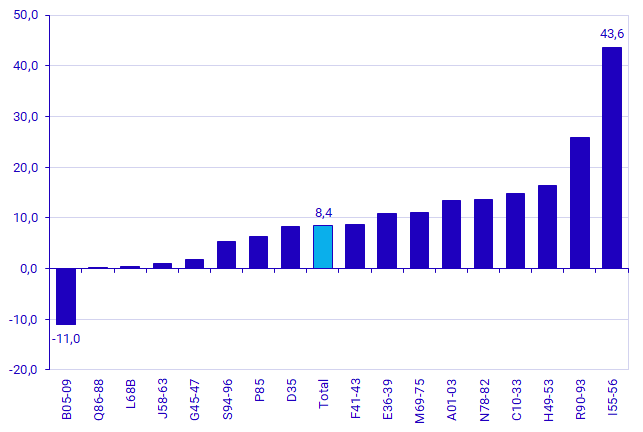Structural Business Statistics 2022
Value added continues to grow in the business sector 2022
Statistical news from Statistics Sweden 2024-05-15 8.00
The recovery in the Swedish business sector continued in 2022. Value added increased with 8 percent compared with 2021. The industry for accommodation and food service activities increased its value added by 43.6 percent.
The business sector consisted in 2022 of just over 1 million enterprises with 3.2 million employees. Total net turnover amounted to SEK 11 962 billion and total assets were SEK 20 641 billion. The enterprises created a value added (contribution to GDP, gross domestic product) of SEK 3 346 billion, which means an increase of about 8 percent compared with 2021.
In terms of numbers, the business sector is dominated by micro enterprises with 0-9 employees (96.3 percent), while it is the largest enterprises (more than 250 employees) that account for the majority of the number of employees (42.3 percent), net turnover (51.3 percent) and value added (47.6 percent). Micro enterprises had about 660 000 employees in total and a net turnover of about SEK 1 866 billion. The largest enterprises had 1 365 000 persons employed in total, and a net turnover of SEK 6 136 billion in 2022.
A positive development of value added
Divided by NACE sections, virtually all industries show a positive development of value added between 2021 and 2022. Only the industry for mining and quarrying (NACE B05-09) shows a negative development rate and decreased with 11 percent. Among the sections with the highest development rates, with a yearly development of 43.6 percent, is the industry for accommodation and food service activities (NACE I55-56). This can be explained by the publics return to restaurants after the lifted corona restrictions in early 2022.

The increased prices in 2022 have had major effects on the business sector, both in terms of production and consumption values, and thus also the value added. The production and consumption values increased with 16.2 and 21.2 percent respectively compared with 2021. Value added increased with approximately 8 percent. If these development rates are put in relation to the price increases, it is evident that a relatively large proportion of the production and consumption increases can be due to increased prices, and not an increased volume. When the production, consumption and value added values for 2022 are expressed in the prices for 2021, i.e. adjusted for the heavily increased prices of 2022, the production value increased with 4.3 percent, and the consumption value with 5.4 percent, resulting in a increase in value added by 2.6 percent.
The figures for 2022 differ significantly from previous publicised data in some respects, as an effect of a more ambitious implementation of statistical units. The differences provide a better understanding of the structure of the business sector, including that larger enterprises play an even more important role than the statistics previously showed. A consequence of this, however, is that it means a break in the time series.
Definitions and explanations
Structural Business Statistics is the only survey that is based on the annual accounts of all non-financial enterprises in Sweden.
All information in this item of statistical news is reported in current prices. All comparisons have been made with final data for 2021.
Net turnover: Net turnover excluding excise taxes and merchanting.
Value added: Actual production minus costs for purchased goods and services, except salaries, payroll taxes and the costs of goods for resale (because only the trade margin for these is included in the production value). Value added can also be referred to as the contribution to GDP (gross domestic product).
Production value: Actual production or output of enterprises during the year. Based on sales, i.e., net turnover, adjusted for changes in inventory and work in progress, capitalized work on own account, other operating income excluding grants, capital gains and the purchase cost of goods for resale (because only the trade margin is included).
Consumption value: Actual consumption used by enterprises during the year. Based on costs of purchased goods and services used as inputs in production, but does not include wages, social security contributions and the purchase of goods for resale.
Employees: Average number of employees, full-time equivalents: two half-time employees are counted as one full-time employee.
Assets: Sum of intangible, tangible and financial fixed assets, and sum of current assets.
Business sector: Enterprises conducting business activities in Sweden regardless of legal form. Businesses with financial activities and housing cooperatives are not included in the Structural Business Statistics. Public administration activities are also not included.
Information on the quality of the statistics, production methods, frequently requested tables, charts, and more is available on the Statistics Sweden website under Structural business statistics (scb.se).
NACE Rev2.: Industrial classification for classifying enterprises into industries according to the activity they conduct. The Swedish equivalent is SNI2007 (Svensk näringsgrensindelning).
Next publishing will be
The next item of statistical news in this series is scheduled for publication on 2024-12-04 at 08:00.
Statistical Database
More information is available in the Statistical Database
Feel free to use the facts from this statistical news but remember to state Source: Statistics Sweden.
